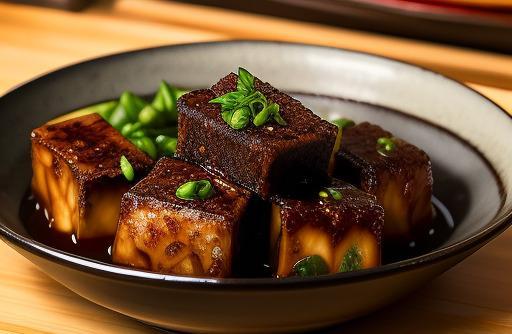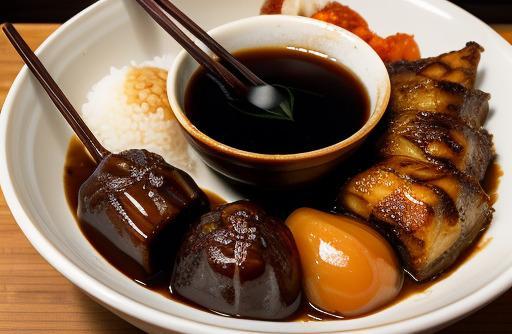- You are here:
- Home »
- Food Substitutes
- » Best Substitutes For Soy Sauce
Best Substitutes For Soy Sauce

Soy sauce is a popular ingredient in many Asian cuisines, known for its savory and umami flavor. However, for various reasons such as allergies, dietary restrictions, or simply running out of the pantry staple, you may find yourself in need of a substitute for soy sauce. Fortunately, there are several alternatives that can provide similar flavors and enhance your dishes. In this article, we will explore the best substitutes for soy sauce, their attributes, and how to use them in cooking.
Key Takeaways
- Soy sauce, a common ingredient in Asian cuisine, is known for its savory and umami flavor.
- There are various reasons to seek a substitute for soy sauce, including allergies, dietary restrictions, or unavailability.
- Substitutes for soy sauce can range from other types of fermented sauces to homemade alternatives.
- The best substitute for soy sauce depends on the desired flavor profile of your dish.
- Some popular substitutes for soy sauce include tamari, coconut aminos, fish sauce, Worcestershire sauce, and homemade soy sauce alternatives.
Why You Need A Substitute For Soy Sauce
There are several reasons why you may need a substitute for soy sauce:
-
Allergies and Dietary Restrictions: Individuals with soy allergies or those following a soy-free diet need alternatives that can provide a similar taste without soy ingredients.
-
Dietary Preferences: Some people prefer to avoid soy-based products for personal or ethical reasons.
-
Low Sodium Diet: Standard soy sauce is high in sodium, which may be unsuitable for individuals on a low sodium diet. Substitutes with reduced or no added sodium can be an excellent option.
-
Supply and Availability: You may find yourself in a situation where soy sauce is not available in your pantry, and you need a suitable replacement for your recipe.
Types Of Substitutes For Soy Sauce

When seeking a substitute for soy sauce, it is crucial to understand the different types of alternatives available. These substitutes can include:
-
Traditional Fermented Sauces: These sauces are made similarly to soy sauce but use alternative ingredients other than fermented soybeans. They provide a similar umami flavor profile.
-
Soy Sauce-Based Alternatives: These substitutes are made with soy sauce as a base but have been modified to suit specific dietary needs, such as being gluten-free or low sodium.
-
Homemade Substitutes: You can also create your own soy sauce alternative by combining various ingredients and seasonings.
Best Substitutes For Soy Sauce
-
Tamari: Tamari is one of the closest substitutes to soy sauce as it is predominantly made from fermented soybeans. However, tamari is often gluten-free, making it a suitable alternative for individuals with gluten sensitivities or following a gluten-free diet. It has a richer and less salty flavor compared to regular soy sauce.
-
Coconut Aminos: Coconut aminos are made from the sap of coconut blossoms and are naturally gluten-free and soy-free. They have a sweet and savory flavor, similar to soy sauce, with a hint of coconut taste. Coconut aminos are lower in sodium compared to soy sauce, making them a healthy alternative for those on a low-sodium diet.
Pro Tip: When using coconut aminos as a substitute for soy sauce, it is advisable to reduce the amount of salt in your recipe to avoid excessive sodium levels.
-
Fish Sauce: Fish sauce is a common ingredient in Southeast Asian cuisine and provides a unique umami flavor to dishes. While it may not taste exactly like soy sauce, it can add depth and complexity to your recipes. It is crucial to note that fish sauce contains anchovies, making it unsuitable for individuals with fish allergies.
-
Worcestershire Sauce: Originating from England, Worcestershire sauce has a tangy and savory flavor that can mimic the umami taste of soy sauce. It contains anchovies, so it may not be suitable for individuals with fish allergies. However, vegan versions of Worcestershire sauce are available.
-
Homemade Soy Sauce Alternatives: If you prefer a DIY approach, you can create your own soy sauce substitute using ingredients such as beef broth, vegetable broth, molasses, apple cider vinegar, and spices. Homemade alternatives allow you to tailor the flavors to your liking and dietary needs.
Choosing The Right Substitute For Soy Sauce

When selecting a substitute for soy sauce, it is essential to consider the flavor profile and sodium content of the alternatives. Here are some considerations to help you choose the right substitute for your recipe:
-
Flavor: Determine the desired flavor profile of your dish. If you prefer a similar taste to soy sauce, tamari or coconut aminos are excellent options. If you are open to slightly different flavors, fish sauce or Worcestershire sauce may be more suitable.
-
Sodium Content: If you are watching your sodium intake, opt for substitutes that are lower in sodium or have no added sodium. Coconut aminos and homemade alternatives are generally lower in sodium compared to standard soy sauce.
-
Allergies and Dietary Restrictions: Consider any allergies or dietary restrictions that you or your guests may have. If soy or gluten is a concern, tamari and coconut aminos are safe choices. For fish allergies, Worcestershire sauce may not be suitable.
Cooking With Substitutes For Soy Sauce
Using substitutes for soy sauce in cooking requires a slight adjustment in measurement and flavor profile. Here are some guidelines to help you successfully incorporate these substitutes into your recipes:
-
Measurement: Substitutes for soy sauce may have different levels of saltiness and intensity, so start by using the same quantity as the recipe suggests. Taste and adjust as needed.
-
Thickening Agents: If the recipe calls for soy sauce as a thickening agent, you may need to experiment with alternative thickeners such as cornstarch or arrowroot powder to achieve the desired consistency.
-
Sauce Reduction: Some substitutes may contain a higher water content, which can affect the texture of the dish. Consider reducing the sauce slightly to achieve the desired thickness.
Recipes Using Substitutes For Soy Sauce

-
Stir-Fried Veggies with Tamari: In a hot wok, sauté your favorite vegetables with minced garlic and ginger. Add tamari, a splash of sesame oil, and a pinch of sugar. Toss until the vegetables are tender but still crisp. Serve over steamed rice.
-
Coconut Aminos Glazed Salmon: Marinate salmon fillets in a mixture of coconut aminos, garlic, honey, and lime juice for 30 minutes. Grill or bake the salmon until it flakes easily with a fork. Serve with steamed vegetables.
-
Pad Thai with Fish Sauce: In a large skillet, stir-fry rice noodles with shrimp, bean sprouts, and scrambled eggs. Make a sauce by mixing fish sauce, tamarind paste, lime juice, and brown sugar. Toss the cooked noodles and vegetables in the sauce until well coated. Serve with crushed peanuts and lime wedges.
-
Mushroom Burger with Worcestershire Sauce: In a food processor, blend cooked mushrooms, breadcrumbs, onion, garlic, and Worcestershire sauce until combined. Shape the mixture into patties and grill or pan-fry until golden brown. Serve on a bun with your favorite burger fixings.
Storage And Shelf Life Of Substitutes
The storage and shelf life of substitutes for soy sauce can vary depending on their ingredients and processing methods. Here are some general guidelines:
-
Tamari: Store tamari in the refrigerator after opening, and it can last up to a year.
-
Coconut Aminos: Coconut aminos can be stored at room temperature, away from direct sunlight. It has a long shelf life of approximately two years.
-
Fish Sauce: Fish sauce does not require refrigeration and can last indefinitely. However, storing it in the refrigerator can help maintain its flavor for a longer period.
-
Worcestershire Sauce: Keep Worcestershire sauce in a cool, dark place, and it can last for several years.
-
Homemade Alternatives: Homemade soy sauce alternatives should be stored in airtight containers in the refrigerator. The shelf life can vary, but it is recommended to consume them within a month.
Conclusion
Whether you have dietary restrictions, are out of soy sauce, or simply want to try something new, there are numerous substitutes available that can provide similar flavors to soy sauce. Tamari, coconut aminos, fish sauce, Worcestershire sauce, and homemade soy sauce alternatives are all excellent options to consider. Remember to adjust the measurements and adapt the seasonings to suit your desired taste. With these substitutes, you can continue to enjoy delicious and flavorful dishes without the need for traditional soy sauce.
FAQS
What Are The Best Substitutes For Soy Sauce?
If you cannot use soy sauce due to any dietary restrictions or simply because you dislike the flavor, there are several alternatives that can be used as a replacement. Some of the best substitutes for soy sauce include coconut aminos, tamari sauce, Worcestershire sauce, fish sauce, and liquid aminos.
Can Coconut Aminos Be Used As A Substitute For Soy Sauce In Cooking?
Yes, coconut aminos can be used as a perfect substitute for soy sauce in most recipes that require the use of soy sauce. It has a similar flavor profile, but is both gluten-free and soy-free, making it an excellent choice for anyone with dietary restrictions.
What Is Tamari Sauce And How Is It Used As A Soy Sauce Substitute?
Tamari is a Japanese sauce that is traditionally made from soybeans but is gluten-free, which makes it ideal for those who cannot consume gluten. It is darker, richer and less salty than soy sauce and can be used as a substitute for soy sauce in most recipes.
Is Worcestershire Sauce A Good Substitute For Soy Sauce In Cooking?
Yes, Worcestershire sauce is a common substitute for soy sauce and can be used in a variety of different dishes. It has a similar umami flavor to soy sauce but with a stronger vinegar taste.
Can Liquid Aminos Be Used As A Low-sodium Substitute For Soy Sauce?
Yes, liquid aminos can be used as a low-sodium substitute for soy sauce. It is made from soybeans and has the same umami flavor as soy sauce but with less sodium. This makes it a great alternative for those watching their salt intake.
Sources
About the Author Jenny
I'm Jenny, a housewife with an unwavering passion for food. My culinary journey began with my grandmother's kitchen, and it's now a full-fledged food blog. I've turned my love for cooking into a creative outlet, sharing recipes and stories with a global community of fellow food enthusiasts. It's proof that being a housewife can also mean pursuing your passions and savoring life's delectable moments.
